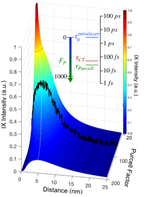Nanocavity clock spectroscopy: Resolving competing exciton dynamics in WSe2/MoSe2 heterobilayers
| Reviews and Highlights | Quantum Science | Molecular and Soft-matter | Ultrafast Nano-optics and Nanophotonics | Mineralogy and Geochemistry |
|---|
Molly A. May, Tao Jiang, Chenfeng Du, Kyoung-Duck Park, Xiaodong Xu, Alexey Belyanin, and Markus B. Raschke
Nano Lett. 21, 522 (2020).
DOI PDF SI

Transition-metal dichalcogenide heterostructures are an emergent platform for novel many-body states from exciton condensates to nanolasers. However, their exciton dynamics are difficult to disentangle due to multiple competing processes with time scales varying over many orders of magnitude. Using a configurable nano-optical cavity based on a plasmonic scanning probe tip, the radiative (rad) and nonradiative (nrad) relaxation of intra- and interlayer excitons is controlled. Tuning their relative rates in a WSe2/MoSe2 heterobilayer over 6 orders of magnitude in tip-enhanced photoluminescence spectroscopy reveals a cavity-induced crossover from nonradiative quenching to Purcell-enhanced radiation. Rate equation modeling with the interlayer charge transfer time as a reference clock allows for a comprehensive determination from the long interlayer exciton (IX) radiative lifetime τIXrad = (94 ± 27) ns to the 5 orders of magnitude faster competing nonradiative lifetime τIXnrad = (0.6 ± 0.2) ps. This approach of nanocavity clock spectroscopy is generally applicable to a wide range of excitonic systems with competing decay pathways.
